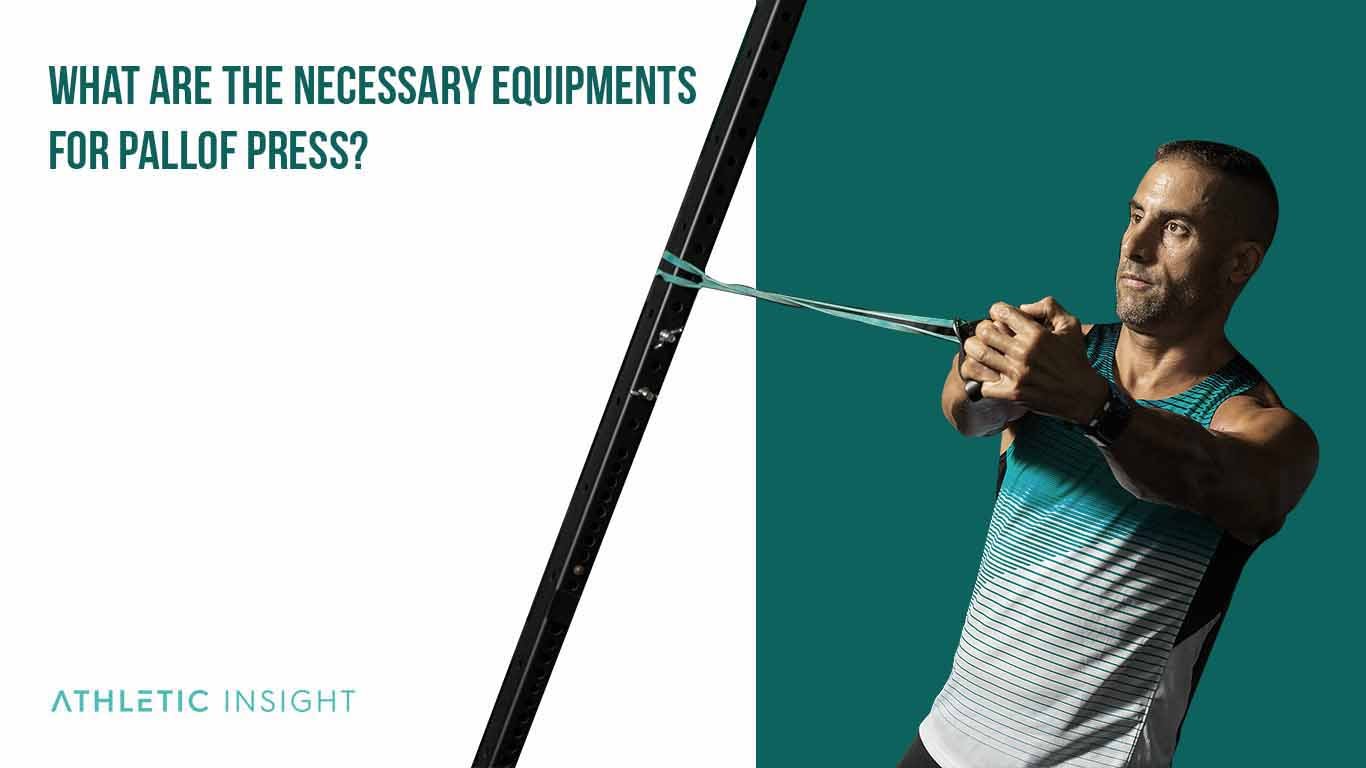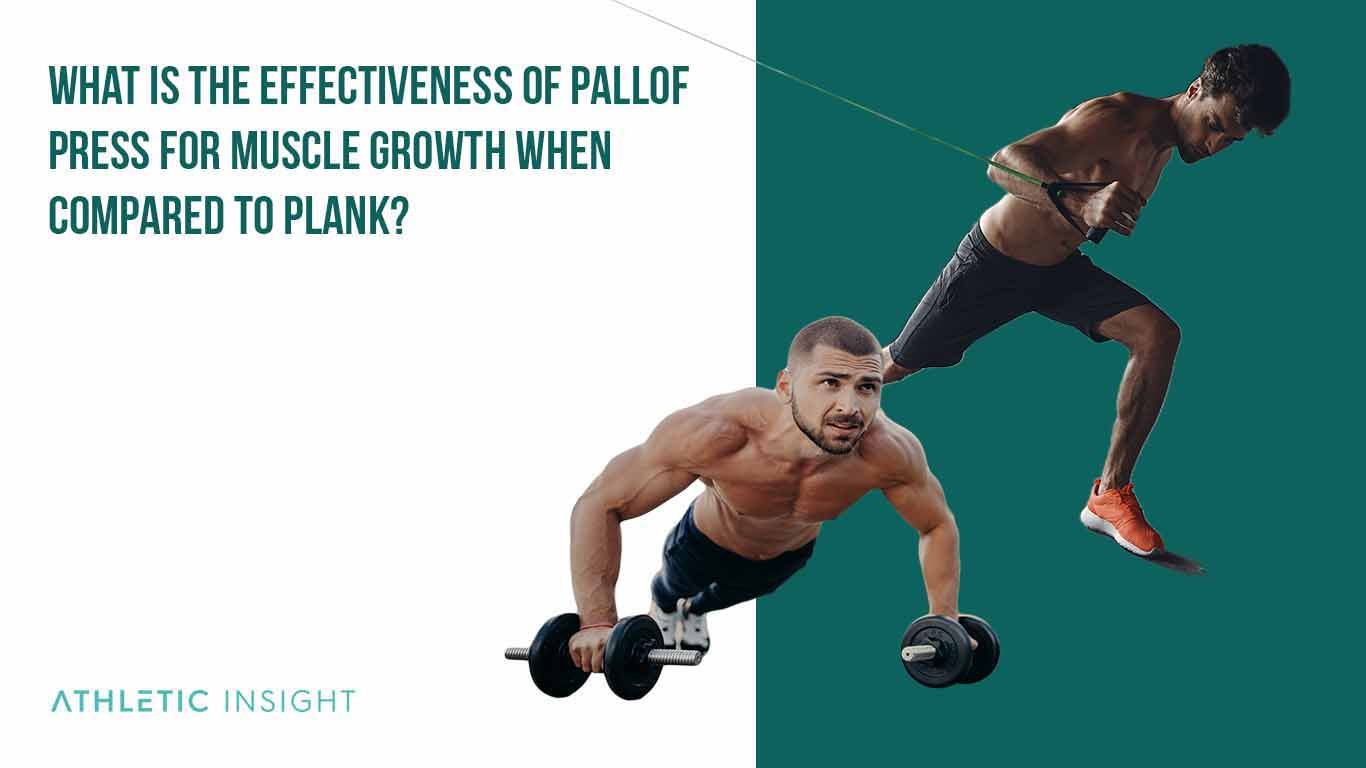The Pallof press is an anti-rotation isometric exercise that works your obliques, rectus abdominals, erector spinae, gluteus medius, and transverse abdominals. Pallof presses are also great for those who don’t want to go to a gym, as all you need is an inexpensive resistance band.
To perform a Pallof press, fix a resistance band to a pole, rack, or something stationary. Then, take a couple of steps to the side while holding onto the resistance band. The band should be pulling you sideways, either towards your left or your right depending on where the band is attached to. Once into position, hold the band in front of your chest with both hands and then press it out in front of you. Then, bring it back in.
The Pallof press appears as though it is a chest press, but the real muscle strain is actually on your abs as you maintain proper form and while the band remains fixed to the stationary object. Be sure to hit both sides of your body by switching sides after one full set. You can also use Pallof press variations like changing the position of the resistance band, kneeling on one knee, or standing on one leg to further isolate the core.
While the concept is simple, there are a few common mistakes that may lead to injuries. When performing the Pallof press, ensure that your arms are tight to your chest and remain in front of you during the press. Some people use too much resistance, improper form, or become tired which causes the arm position to become compromised.
If you find your arm bending backwards towards the stationary object, take a step closer to the rack/pole or use a resistance band with less poundage to ensure that your elbows do not rotate. This may lead to joint pain and muscle tears if you continue to stress the elbows in this manner.
How to Perform Pallof Press with Proper Form?
To dominate the Pallof press, you will need proper form. To start, you will need either a resistance band or a cable machine in a gym. If you’re using a resistance band, you will need to secure one end to something about shoulder height.
When you perform the Pallof press, you’ll be standing next to the cable machine or resistance band with the end held against your chest. You will want to be standing straight, with your feet about shoulder-width apart and your knees slightly bent. You will also want to have your core engaged during the this abs exercise.
What are the benefits of Pallof Press?
Here you can see the benefits of Pallof Press.
- Improved anti-rotational strength
- Versatility
- Side plank alternative
- Great warmup exercise
1. Improved anti-rotational strength
Anti-rotational exercises build muscles around your spine. These are critical for everyday movements that include twisting or bending. They provide excellent stability and core strength.
2. Versatility
Unlike many other exercises that require expensive equipment, the Pallof the press is easy to do with just a resistance band and can be done anywhere. It is a great exercise to add to your routine to switch things up.
3. Side plank alternative
If you have an injury, or you haven’t yet gained the muscles needed to hold a side plank, the Pallof press is a wonderful alternative.
4. Great warm up exercise
Thanks to its easy setup and general ease of use, the Pallof press is a great option for a warm up exercise. It is particularly useful if you need the benefits of an anti-rotational exercise.
What are the mistakes for Pallof Press form?
There are three main mistakes people make while performing the Pallof press, either locking the knees, not fully extending the arms, or using too much weight. You should avoid common pallof press mistakes.
How to Determine Proper Weight for Pallof Press?
Start with low weight and work your way up. The goal is to maintain a good Pallof press form no matter the weight you are using.

What is the importance of grip for Pallof Press?
You don’t need a lot of grip with the Pallof press. The resistance from the cable machine or resistance band will be pulled from the side of your hand. Given that you have a proper weight for your strength level, you shouldn’t have to worry about grip.
Which muscles are involved while performing Pallof Press?
A full list of the muscles used during a Pallof press is the obliques, rectus abdominals, erector spinae, gluteus medius, and transverse abdominals.
How to do Pallof Press?
To dominate the Pallof press, follow these instructions.
- Using the handle attachment of the Pallof Press.
- Grip the handle tightly with both hands.
- Take a few steps back.
- Spread your feet shoulder-width apart.
- Maintain a small bend in your knees.
- Grip the handle tight to your chest.
- Brace your core.
- Press your arms straight ahead when you’re ready.
- Slowly bring your arms back in
- Extend the arms.
- Draw them back in and repeat.
1. Using the handle attachment of the Pallof Press.
The handle attachment will be used with a cable machine. The handle will be at about shoulder height. Remember to adjust the weight prior to starting the exercise.
Alternatively, you can use a resistance band that is secured at about shoulder height to something solid, like a wall.
2. Grip the handle tightly with both hands.
Take the handle (or other end of the resistance band) to get into position to perform the Pallof press.
3. Take a few steps back.
Taking a few steps back will provide the tension necessary for the exercise.
4. Spread your feet shoulder-width apart.
For proper form, you should keep your feet about shoulder-width apart while performing the Pallof press.
5. Maintain a small bend in your knees.
A small bend in your knees will stop you from locking your knees, which can cause injury.
6. Grip the handle tight to your chest.
At the starting point of the Pallof press, the handle will be held against your chest.
7. Brace your core.
Bracing your core will ensure that you keep a good strong posture through the exercise and will also keep you from twisting.
8. Press your arms straight ahead when you’re ready.
Now it is time to do the Pallof press. Pressing your arms out straight with the resistance band or cable machine handle in your hand provides lateral resistance.
9. Slowly bring your arms back in.
Step two of the Pallof press is to bring your arms back to the starting position.
10. Extend the arms.
Now you will begin to make your reps. When you are ready, press out your arms again.
11. Draw them back in and repeat.
Slowly bring your arms back in. After this, you will repeat for as many reps as you wish. Remember to maintain good form.
What are the Pallof Press Variations?
Here you can see the variations of Pallof Press.
- Half-Kneeling Pallof Press
- Cable Pallof Press
- Kneeling Pallof Press
- Pallof Press with Rotation
- Split Stance Pallof Press
- Single-Leg Pallof Press
- Pallof Press Iso Hold
1. Half-Kneeling Pallof Press
In this variation, you perform the Pallof press while kneeling on one knee. You can use a cushion or pad to make it more comfortable.
2. Cable Pallof Press
Simply the name of the Pallof press being performed with a cable machine.
3. Kneeling Pallof Press
Instead of kneeling on one knee (as with the half-kneeling Pallof press), you are on both knees.
4. Pallof Press with Rotation
Begin as you would with a normal Pallof press. Once you are fully extended, add a rotation away from the cable machine or resistance band. You should feel increased tension.
5. Split Stance Pallof Press
Similar to the half-kneeling Pallof press in which one foot is in front of the other. In this variation, however, both knees are still off the floor. It appears much like a lunge.
6. Single-Leg Pallof Press
For added difficulty and to further strengthen stabilizing muscles, this variation is performed on one leg.
7. Pallof Press Iso Hold
When your arms are extended, hold them out for several seconds. Be sure to maintain form and not lock your elbows.
What are the necessary equipments for Pallof Press?
For a Pallof press, you either need a cable machine or a resistance band.

What are the world records for Pallof Press?
There is no world record for the Pallof press.
What is the origin of Pallof Press?
The Pallof press is also known as the belly press and was first used by a physical therapist named John Pallof as a means to protect and strengthen the backs of his patients.
Who named the Pallof Press?
The pallof press was named after John Pallof.
Which muscles can be affected more by Pallof Press?
The muscles used the most are the rectus abdominis. These are also known as the six-pack muscles, which makes this exercise great for chiseling out abs.
What are the abs muscle exercises with Pallof Press?
In the Pallof press, the ribcage is being pulled towards the pelvis. Also, while holding the resistance band or cable handle out, the abs and obliques are working to keep your torso from twisting with the lateral tension.
What is the effectiveness of Pallof Press for muscle growth when compared to Plank?
Pallof press and plank work many of the same muscle groups. However, the plank can be difficult for those who don’t already have the muscles required to hold themselves up or those who have an injury in their shoulders, arms, or wrists.

What are the Pallof Press-related facts?
There are some reasons why the Pallof Press is the best exercise. The Pallof press is an exercise that everyone should learn as it keeps the muscles around the spine strong. It is one of the best exercises for increasing stability and teaches the body to maintain form under tension.
Does Pallof Press affect the hormones?
The Pallof Press affects hormones as much as all exercise does.
Does Pallof Press Increase Testosterone?
Yes, the Pallof Press increases testosterone, temporarily. This is true with all exercises though.
Does Pallof Press affect the mood?
Yes, the Pallof Press can affect your mood. In fact, all exercises create endorphins, which can elevate mood.
Is Pallof Press practiced within CrossFit?
Yes, the Pallof press is often used in CrossFit to strengthen stability.
Is Pallof Press a military movement?
No, the Pallof press is not a military exercise but it may be used for physical therapy.
Is Pallof Press dangerous?
No, the Pallof press is not dangerous. If done correctly, it can be very safe and beneficial.
Is Pallof Press push or pull?
A Pallof press is a push.
Is Pallof Press essential?
Yes, the Pallof press is essential as it improves core strength to help the body maintain good form under pressure.
Is Pallof Press an Olympic lift?
No, the Pallof press is not an Olympic lift. An Olympic lift is more complex and hardly exercises like weightlifting.
Is Pallof Press a compound exercise?
Yes, the Pallof press is a compound exercise. The Pallof press works for several muscle groups at one time, focusing on the core.
What are the Alternatives of the Palloff Press Exercise?
Here are some alternatives to the Pallof press.
- Plank
- Side Plank
- Crunches
- Hollow Body Hold
- Plank Shoulder Taps
- Glute Bridge
- Kettlebell Drag Through
- V-Ups
- Leg Raises
- Russian Twists
- Butterfly Sit-ups
- Hanging Knee Raise
- Flutter Kicks
- Bird-Dogs
- Supine Toe Taps
- Bicycle Crunches
- Mountain Climbers
- Dead Bugs
- Barbell Rollout
- Cable Woodchop
- Toe Touches



